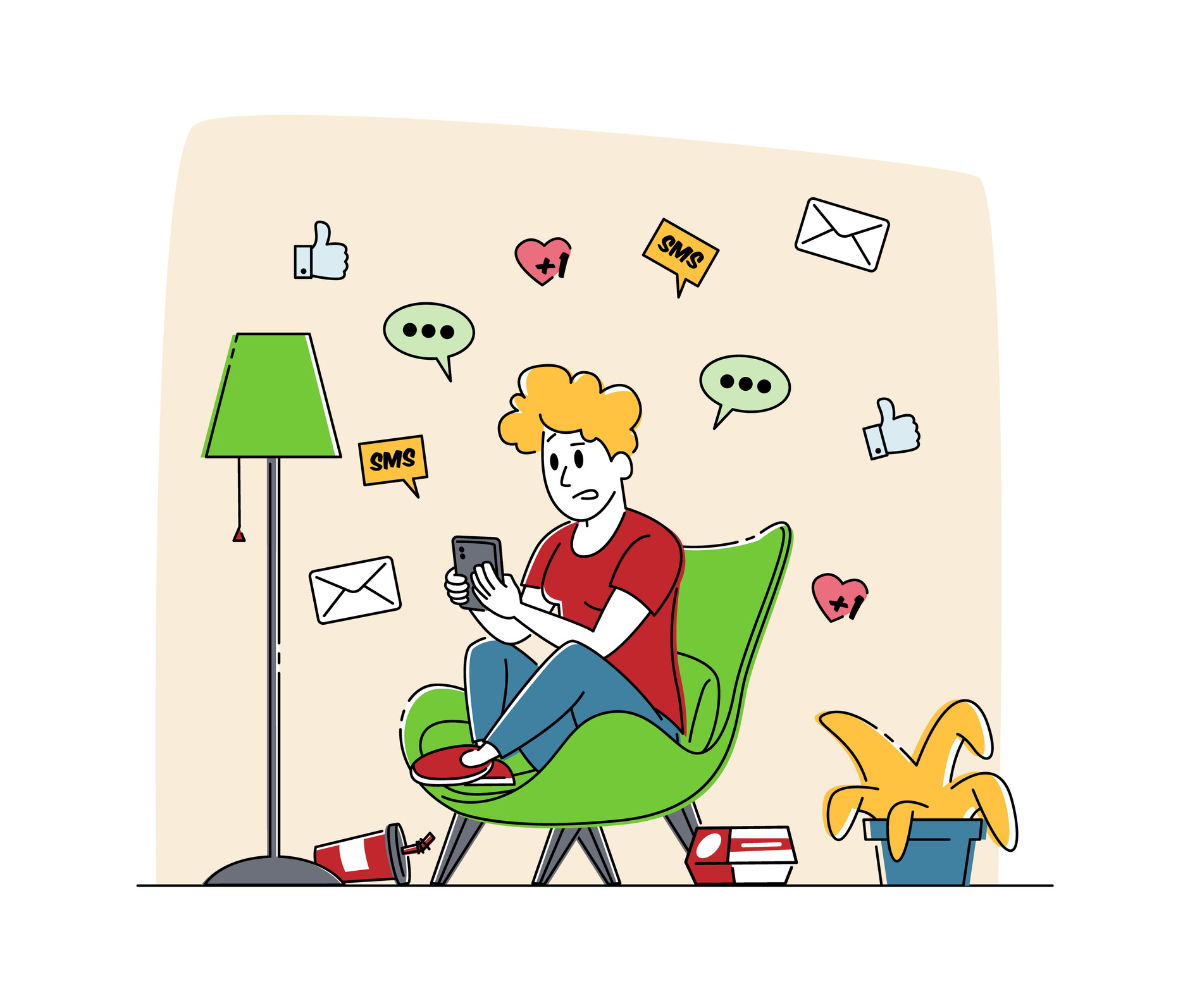Tech Addiction or Habit? 5 Ways To Assess Your Social-Media Use
Compulsively checking feeds, never feeling satisfied and being anxious without your phone are clues that your social-media use isn’t healthy.
We all feel like we’re addicted to our phones at times, mindlessly scrolling through Instagram or chiming in on the latest Twitter scandal—even when we suspect we shouldn’t. How we address our behaviour depends on whether we truly have an addiction, or an unhealthy habit we can kick with a few adjustments.
People throw around the word addiction loosely, but few people are truly dependent on social media, according to mental-health experts. Addiction itself is a spectrum disorder that can range from mild to severe, and treatment can require therapy and a lengthy break.
Even if we’re not addicted, it’s clear that we’re all using social media a lot. A Pew Research Center study last year found that 70% of Facebook users visit the site every day, and that almost half of those daily users access it several times a day.
Here are five general signs that a bad habit might be developing into something more serious—plus tips on how to slow your scroll.
You use social media compulsively.
It’s hard to leave our phones behind when we go anywhere anymore because of the pressure to always be reachable by our bosses, our partners, our kids. When we carry our phones around with us like an extra appendage, it’s hard not to fill free moments by checking social media during an elevator ride, a trip to the bathroom or a stroll in the park.
So what constitutes compulsive use? A 2019 paper in the journal Neuropsychology Review defined compulsive behaviour as the feeling we have to do something repeatedly, even when we know we really don’t have to.
When the compulsion to scroll overrides our better judgment, causing us to do dangerous things such as checking notifications while driving or crossing the road, that’s a reason to pay attention. (On recent mornings, I’ve seen a woman pushing her baby stroller along a busy street in my neighbourhood while staring at her phone.)
Habits aren’t easy to kick because they tend to be done on autopilot, said Phil Reed, chair of the psychology department at Swansea University in Wales, who has been studying the root causes of unhealthy social-media use. “The way to treat habits is to bring them into consciousness and make yourself aware of what you’re doing,” he said.
Tips: Try logging how often you check your feeds in a day, including those brief glances during spare moments. Turn off app notifications, set a blanket Do Not Disturb, or customize Focus settings on Apple devices to automatically turn on during work hours or when you’re driving.
Next, fill the time you normally spend on social media with other activities.
“If you don’t increase other things as you reduce social media, almost any other attempt to reduce it won’t work,” said Cal Newport, an associate professor of computer science at Georgetown University and author of “Digital Minimalism: Choosing a Focused Life in a Noisy World.”
Your social-media use is getting in the way of life.
Anna Lembke, a professor of psychiatry and addiction medicine at Stanford University School of Medicine, relies on this simple definition of addiction: “The continued compulsive use of a substance or behaviour despite harm to self and/or others.”
Scrolling through interior-design photos on Instagram before bed (um, totally speaking for a friend here) likely won’t hurt you, as long as you’re not delaying sleep too much.
If your social-media use is hurting your relationships, your work, your sleep or other aspects of your health—but you scroll anyway because you feel you can’t stop—it’s time to take action.
Tips: Dr. Lembke recommends that people who want to kick a habit do what she calls a “24-hour dopamine fast” by not touching any screen-related devices for a day.
“Prepare for the fast by letting people know you won’t be reachable,” said Dr. Lembke, who wrote “Dopamine Nation: Finding Balance in the Age of Indulgence.” It’s also better to do the fast with friends or family, she said.
People should pay close attention to how they’re feeling during the fast, Dr. Lembke said, and note symptoms such as anxiousness, irritability and intrusive thoughts about getting back to their feeds.
“Hopefully by the end of that day, people will have experienced a lessening of those symptoms and discover that they’re actually feeling better,” she said.
For people who suspect they have a full-blown tech addiction, she recommends a 30-day screen fast. She said she realizes how daunting that sounds, but it takes about a month of abstaining from addictive behaviours and substances for the reward pathways in the brain to reset.
You need more social media to feel satisfied.
As with any type of substance or behaviour dependence, social-media overuse can lead to increased tolerance to its pleasurable effects, which requires you to seek out more to feel good, Dr. Reed said.
If you’re not sure whether you’ve been ramping up your time on social media, track your app usage over time by looking at the screen-time settings on your phone.
Tips: Dr. Lembke suggests restricting phone use to certain hours of the day and setting time limits on the apps that suck you in the most.
It can help to write down what you plan to do on your phone before you use it, as a way of keeping yourself honest, she said. “If you do want to use it in an escapist, mind-numbing way, limit the amount of time you’ll do that, and schedule it in.” (See, you can take that nightly Instagram break you need!)
You’ve convinced yourself that you have an audience you need to serve.
This doesn’t apply to influencers who make a living posting on social media—which is not to say their use can’t be problematic. It’s intended for the teens and parents alike who have told me they feel pressure to post frequently.
Tips: Dr. Newport suggests you conduct an experiment and stop posting for a while without telling anyone, and see if anyone remarks on your absence. “People often find that no one notices,” he said.
You also could share directly with one person or a small group through traditional messaging, or new photo-sharing apps popular with Gen Z.
You suffer from withdrawal symptoms when you’re not on social media.
If you experience anxiety, irritability, insomnia, depression and strong cravings for social media when you’re not using it, that’s an indication of addiction.
Tips: Dr. Newport suggests using a decluttering approach to social media, much like getting rid of old clothes in your closet to make room for new ones. First, he said, delete all social-media apps from your phone. Take two weeks to a month to clear your head.
Then, slowly and intentionally, add back apps that serve a specific purpose, and develop rules around using them. For example, if Facebook was a way to communicate with your local running group, promise yourself that you will use Facebook solely for that purpose.
For people who feel they have a serious addiction, therapy may be needed to treat the underlying causes.
After you’ve followed the other tips above, schedule a recurring digital break—say one day a week—to reinforce your healthier new habits.
“If you’re not addicted to social media but struggling with overuse, my experience is that having a ‘digital sabbath’ is enough of a reminder to moderate our consumption,” Dr. Lembke said. “Even if it doesn’t make brain changes, it keeps it top of mind.”
Reprinted by permission of The Wall Street Journal, Copyright 2021 Dow Jones & Company. Inc. All Rights Reserved Worldwide. Original date of publication:
 Copyright 2020, Dow Jones & Company, Inc. All Rights Reserved Worldwide. LEARN MORE
Copyright 2020, Dow Jones & Company, Inc. All Rights Reserved Worldwide. LEARN MORE
This stylish family home combines a classic palette and finishes with a flexible floorplan
Just 55 minutes from Sydney, make this your creative getaway located in the majestic Hawkesbury region.
As Paris makes its final preparations for the Olympic games, its residents are busy with their own—packing their suitcases, confirming their reservations, and getting out of town.
Worried about the hordes of crowds and overall chaos the Olympics could bring, Parisians are fleeing the city in droves and inundating resort cities around the country. Hotels and holiday rentals in some of France’s most popular vacation destinations—from the French Riviera in the south to the beaches of Normandy in the north—say they are expecting massive crowds this year in advance of the Olympics. The games will run from July 26-Aug. 1.
“It’s already a major holiday season for us, and beyond that, we have the Olympics,” says Stéphane Personeni, general manager of the Lily of the Valley hotel in Saint Tropez. “People began booking early this year.”
Personeni’s hotel typically has no issues filling its rooms each summer—by May of each year, the luxury hotel typically finds itself completely booked out for the months of July and August. But this year, the 53-room hotel began filling up for summer reservations in February.
“We told our regular guests that everything—hotels, apartments, villas—are going to be hard to find this summer,” Personeni says. His neighbours around Saint Tropez say they’re similarly booked up.
As of March, the online marketplace Gens de Confiance (“Trusted People”), saw a 50% increase in reservations from Parisians seeking vacation rentals outside the capital during the Olympics.
Already, August is a popular vacation time for the French. With a minimum of five weeks of vacation mandated by law, many decide to take the entire month off, renting out villas in beachside destinations for longer periods.
But beyond the typical August travel, the Olympics are having a real impact, says Bertille Marchal, a spokesperson for Gens de Confiance.
“We’ve seen nearly three times more reservations for the dates of the Olympics than the following two weeks,” Marchal says. “The increase is definitely linked to the Olympic Games.”

Getty Images
According to the site, the most sought-out vacation destinations are Morbihan and Loire-Atlantique, a seaside region in the northwest; le Var, a coastal area within the southeast of France along the Côte d’Azur; and the island of Corsica in the Mediterranean.
Meanwhile, the Olympics haven’t necessarily been a boon to foreign tourism in the country. Many tourists who might have otherwise come to France are avoiding it this year in favour of other European capitals. In Paris, demand for stays at high-end hotels has collapsed, with bookings down 50% in July compared to last year, according to UMIH Prestige, which represents hotels charging at least €800 ($865) a night for rooms.
Earlier this year, high-end restaurants and concierges said the Olympics might even be an opportunity to score a hard-get-seat at the city’s fine dining.
In the Occitanie region in southwest France, the overall number of reservations this summer hasn’t changed much from last year, says Vincent Gare, president of the regional tourism committee there.
“But looking further at the numbers, we do see an increase in the clientele coming from the Paris region,” Gare told Le Figaro, noting that the increase in reservations has fallen directly on the dates of the Olympic games.
Michel Barré, a retiree living in Paris’s Le Marais neighbourhood, is one of those opting for the beach rather than the opening ceremony. In January, he booked a stay in Normandy for two weeks.
“Even though it’s a major European capital, Paris is still a small city—it’s a massive effort to host all of these events,” Barré says. “The Olympics are going to be a mess.”
More than anything, he just wants some calm after an event-filled summer in Paris, which just before the Olympics experienced the drama of a snap election called by Macron.
“It’s been a hectic summer here,” he says.

AFP via Getty Images
Parisians—Barré included—feel that the city, by over-catering to its tourists, is driving out many residents.
Parts of the Seine—usually one of the most popular summertime hangout spots —have been closed off for weeks as the city installs bleachers and Olympics signage. In certain neighbourhoods, residents will need to scan a QR code with police to access their own apartments. And from the Olympics to Sept. 8, Paris is nearly doubling the price of transit tickets from €2.15 to €4 per ride.
The city’s clear willingness to capitalise on its tourists has motivated some residents to do the same. In March, the number of active Airbnb listings in Paris reached an all-time high as hosts rushed to list their apartments. Listings grew 40% from the same time last year, according to the company.
With their regular clients taking off, Parisian restaurants and merchants are complaining that business is down.
“Are there any Parisians left in Paris?” Alaine Fontaine, president of the restaurant industry association, told the radio station Franceinfo on Sunday. “For the last three weeks, there haven’t been any here.”
Still, for all the talk of those leaving, there are plenty who have decided to stick around.
Jay Swanson, an American expat and YouTuber, can’t imagine leaving during the Olympics—he secured his tickets to see ping pong and volleyball last year. He’s also less concerned about the crowds and road closures than others, having just put together a series of videos explaining how to navigate Paris during the games.
“It’s been 100 years since the Games came to Paris; when else will we get a chance to host the world like this?” Swanson says. “So many Parisians are leaving and tourism is down, so not only will it be quiet but the only people left will be here for a party.”
This stylish family home combines a classic palette and finishes with a flexible floorplan
Just 55 minutes from Sydney, make this your creative getaway located in the majestic Hawkesbury region.






















